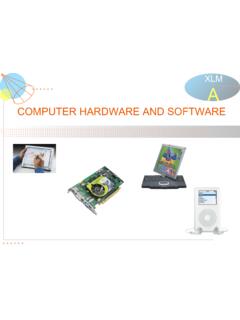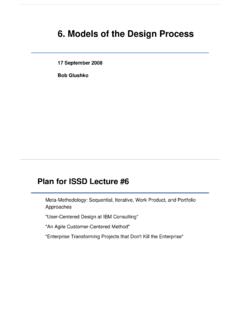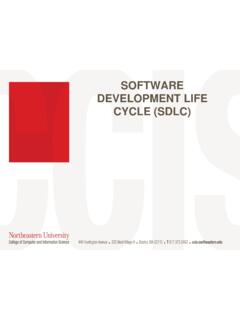Transcription of Chapter 6 SYSTEMS DEVELOPMENT Phases, Tools, and …
1 McGraw-Hill 2008 The McGraw-Hill Companies, Inc. All rights 6 Chapter 6 SYSTEMS DEVELOPMENTP hases, Tools, and TechniquesPhases, Tools, and Techniques6-2 STUDENT LEARNING the traditional SYSTEMS DEVELOPMENT life cycle (SDLC) and describe the 7 major phases within and contrast the various component-based DEVELOPMENT the selfsourcing process as an alternative to the traditional LEARNING the importance of prototyping and prototyping within any SYSTEMS DEVELOPMENT the outsourcing environment and how outsourcing LIVES THROUGH SYSTEMS DEVELOPMENT Centers for Disease Control (CDC)
2 Tracks a wealth of information Antimicrobial-resistant infections in hospitals Influenza outbreaks Terrorist biochemical attacks Bacteria counts in rivers and stagnant ponds, etc Unfortunately, most of that information is stored in separate IT SYSTEMS that do not communicate with each other 6-5 SAVING LIVES THROUGH SYSTEMS DEVELOPMENT The CDC is using a service-oriented architecture (SoA) to integrate all those SYSTEMS and information An SoA treats every component of an IT system a database file, a server, a CRM software solution, etc as a building block Within an SoA, those building blocks can be plugged and played so that everything works together in an integrated fashion6-6 SAVING LIVES THROUGH SYSTEMS DEVELOPMENTlAll computers use a common binary base language.
3 That being true, why is it so difficult to get computer SYSTEMS to easily communicate with each other?lIn SYSTEMS DEVELOPMENT , prototyping is used to build a model of a proposed system. How have you used prototyping in your personal life?lOutsourcing going to another company for SYSTEMS DEVELOPMENT is big business. Why would the CDC not want to pursue outsourcing?6-7 INTRODUCTION Information SYSTEMS are the support structure for meeting the company s strategies and goals New SYSTEMS are created because employees request them New SYSTEMS are created to obtain a competitive advantage6-8 INTRODUCTION When developing a new system, you have 3 who IT specialists inside your organizationlSelfsourcing do-it-yourself approach many end users take with little or no help from IT specialistslOutsourcing a third-party organization ( , let someone do the work and pay them for it)
4 6-9 Chapter and the SDLC Learning outcome # DEVELOPMENT Learning outcome # Learning outcome # Learning outcome # Learning outcome #56-10 INSOURCING AND THE SDLC SYSTEMS DEVELOPMENT life cycle (SDLC) - a structured step-by-step approach for developing information SYSTEMS 7 distinct phases, each with well-defined activities Also called a waterfall methodology , an approach in which each phase of the SDLC is followed by another, from planning through implementation6-11 SDLC Phases & Major Activities6-12 SDLC as a Waterfall Methodology6-13 Phase 1.
5 Planning Planning phase - create a solid plan for developing your information system Three primary planning the system to be developed You can t build every system, so you make choices based on your organization s priorities, which may be expressed as critical success factors Critical success factor (CSF) - a factor simply critical to your organization s success 6-14 Phase 1: Planning Set the project scope Project scope - clearly defines the high-level system requirements Scope creep - occurs when the scope of the project increases Feature creep - occurs when developers add extra features that were not part of the initial requirements Project scope document - a written definition of the project scope and is usually no longer than a paragraph 6-15 Phase 1.
6 Planning Develop the project plan including tasks, resources, and timeframes Project plan - defines the what, when, and who questions of system DEVELOPMENT Project manager - an individual who is an expert in project planning and management, defines and develops the project plan and tracks the plan to ensure all key project milestones are completed on time Project milestones - represent key dates for which you need a certain group of activities performed 6-16 Phase 1: PlanningSample Project Plan6-17 Phase 2: Analysis Analysis phase - involves end users and IT specialists working together to gather, understand, and document the business requirements for the proposed system 6-18 Phase 2.
7 Analysis Two primary analysis the business requirements Business requirements - the detailed set of knowledge worker requests that the system must meet in order to be successful Business requirements address the why and what of your DEVELOPMENT activities Joint application DEVELOPMENT (JAD) - knowledge workers and IT specialists meet, sometimes for several days, to define or review the business requirements for the system 6-19 Phase 2: the requirements Requirements definition document prioritizes the business requirements and places them in a formal comprehensive document Again, you probably can t do everything, so prioritizing is important Users sign off on this document which clearly sets the scope for the project6-20 Phase 2: AnalysisTake time during analysis to get the business requirements correct.
8 If you find errors, fix them immediately. The cost to fix an error in the early stages of the SDLC is relatively small. In later stages, the cost is 3: Design Design phase - build a technical blueprint of how the proposed system will work Two primary design activities: Design the technical architecture Technical architecture - defines the hardware, software , and telecommunications equipment required to run the system 6-22 Phase 3: Design Design system models This includes GUI screens that users will interface with, database designs (see XLM/C), report formats, software steps, etc Starting with design, you take on less of an active participation role and act more as a quality control function, ensuring that the IT people are designing a system to meet your needs6-23 Phase 4.
9 DEVELOPMENT DEVELOPMENT phase - take all of your detailed design documents from the design phase and transform them into an actual system Two primary DEVELOPMENT the technical the database and programs Both of these activities are mostly performed by IT specialists6-24 Phase 5: Testing Testing phase - verifies that the system works and meets all of the business requirements defined in the analysis phase Two primary testing the test conditions Test conditions - the detailed steps the system must perform along with the expected results of each step 6-25 Phase 5.
10 The testing of the system Unit testing tests individual units of code System testing verifies that the units of code function correctly when integrated Integration testing verifies that separate SYSTEMS work together User acceptance testing (UAT) determines if the system satisfies the business requirements 6-26 Phase 6: Implementation Implementation phase - distribute the system to all of the knowledge workers and they begin using the system to perform their everyday jobs Two primary implementation detailed user documentation User documentation - highlights how to use the system 6-27 Phase 6: training for the system users Online training - runs over the Internet or off a CD-ROM Workshop training - is held in a classroom environment and lead by an instructor 6-28 Phase 6.

















